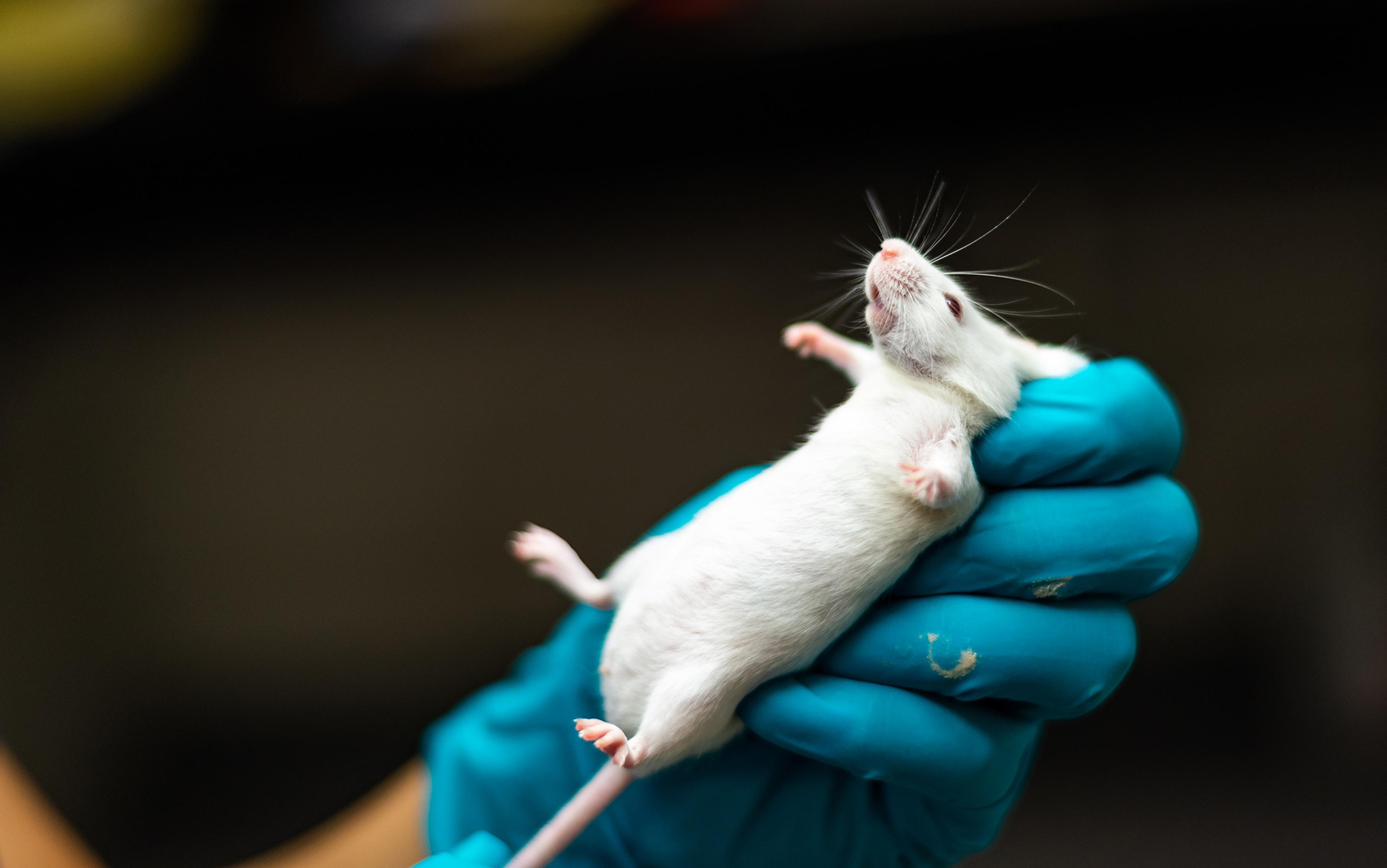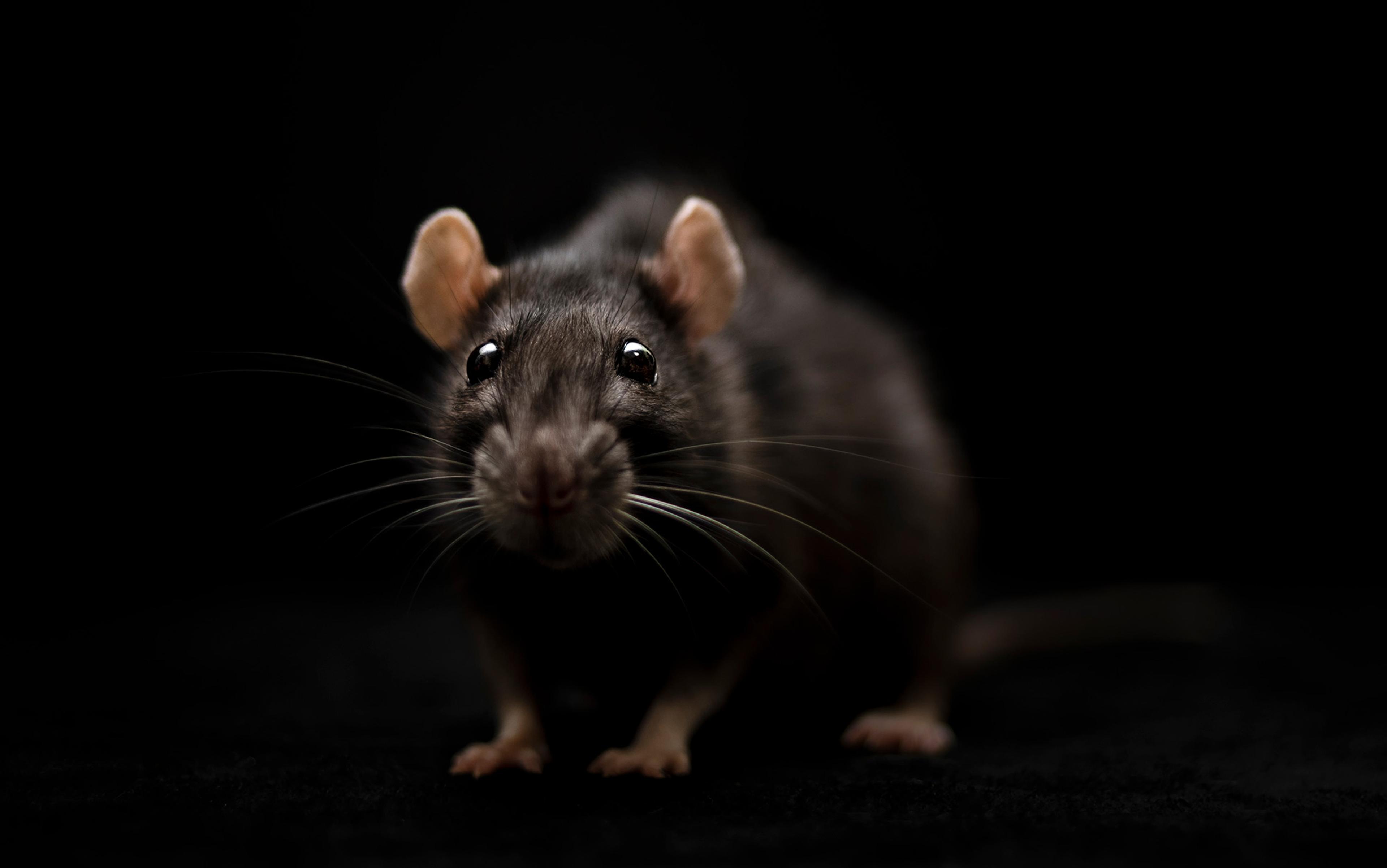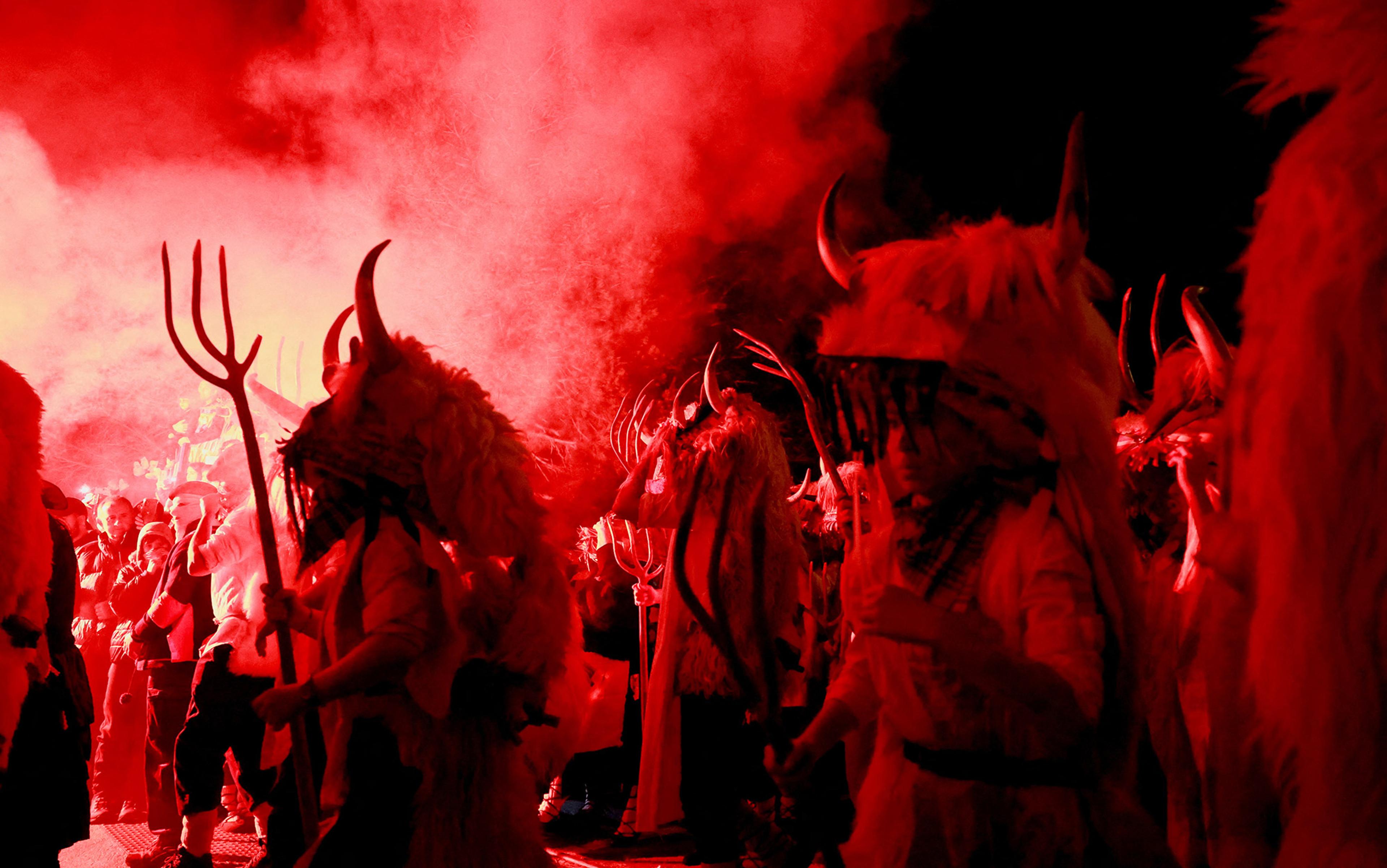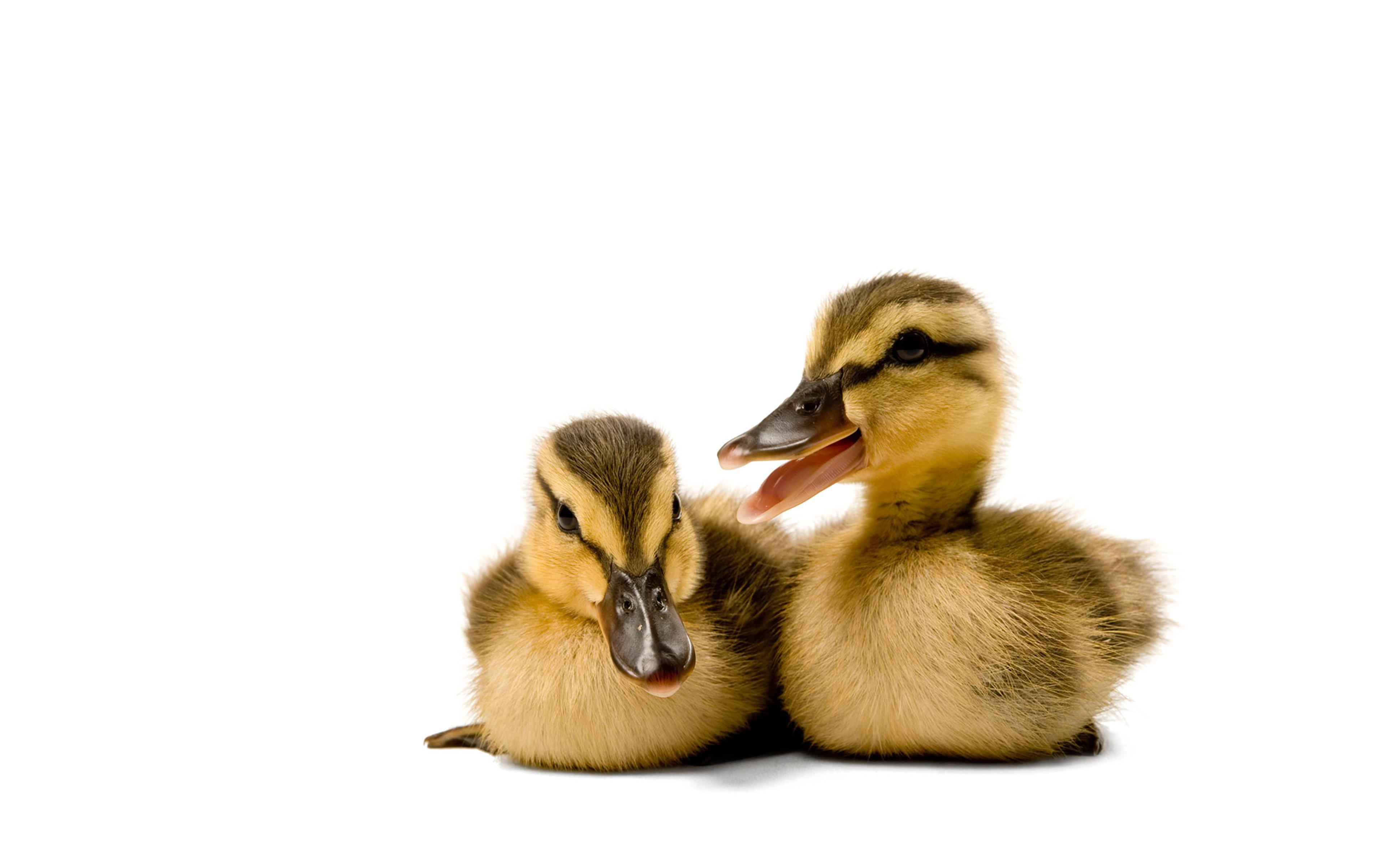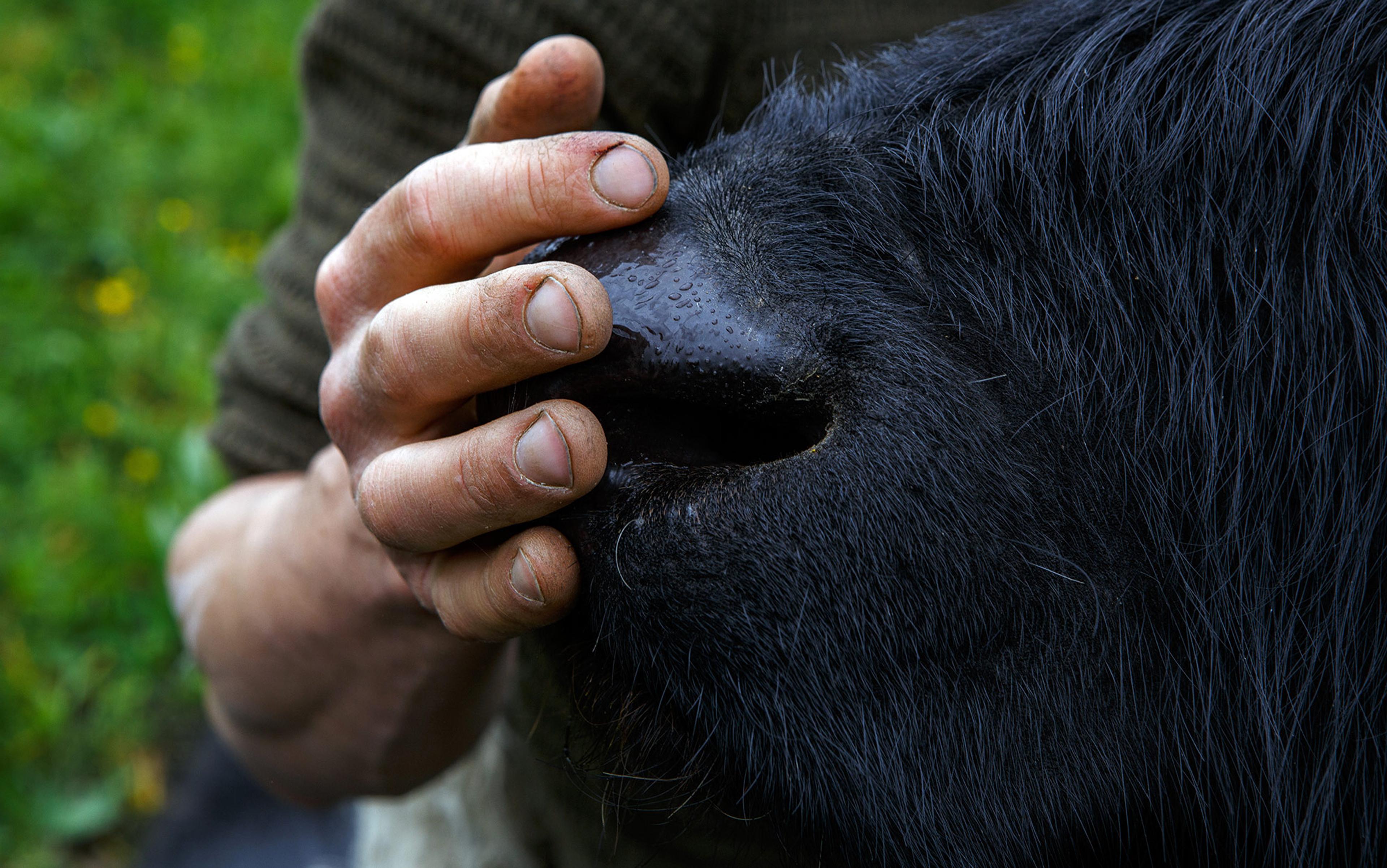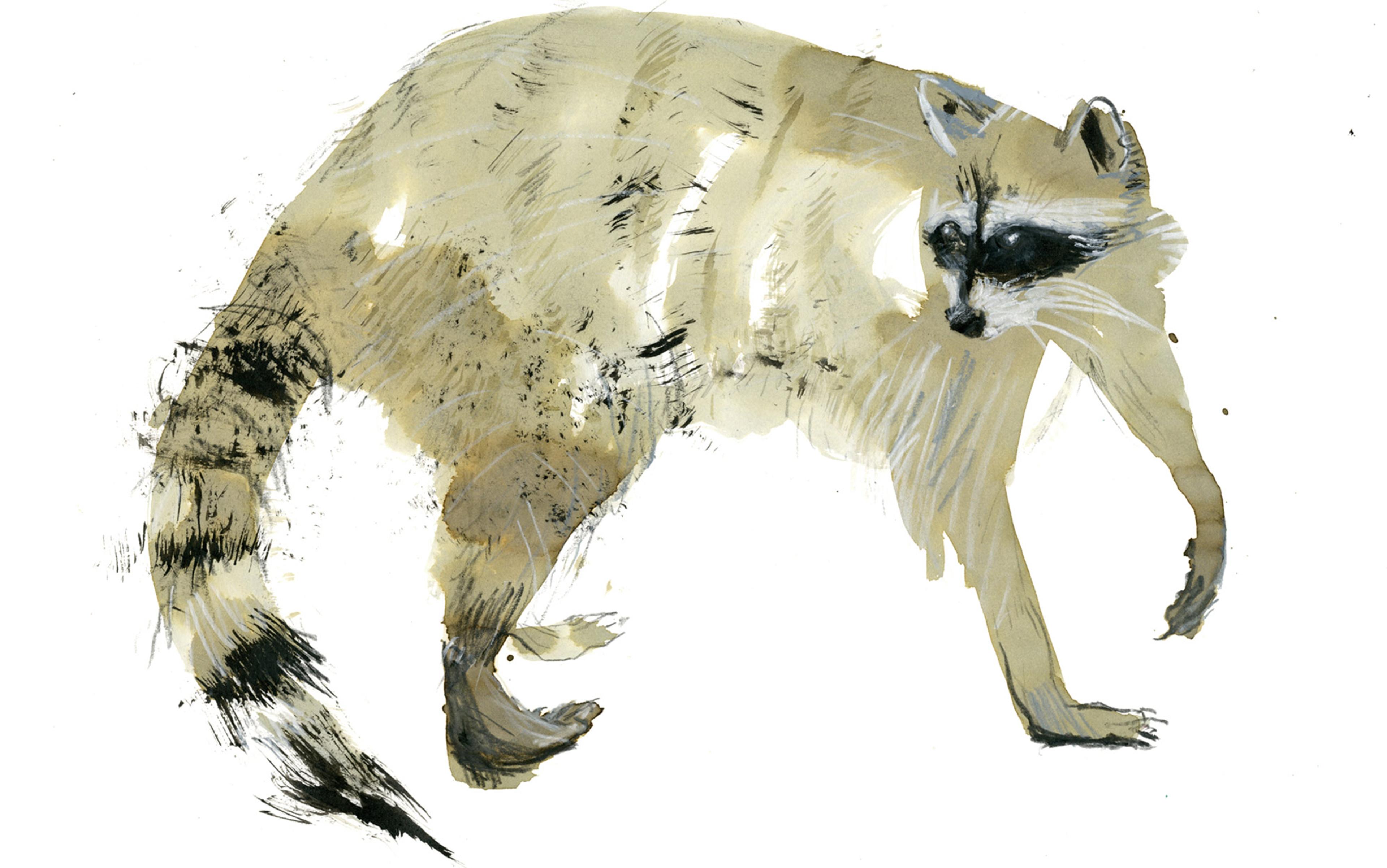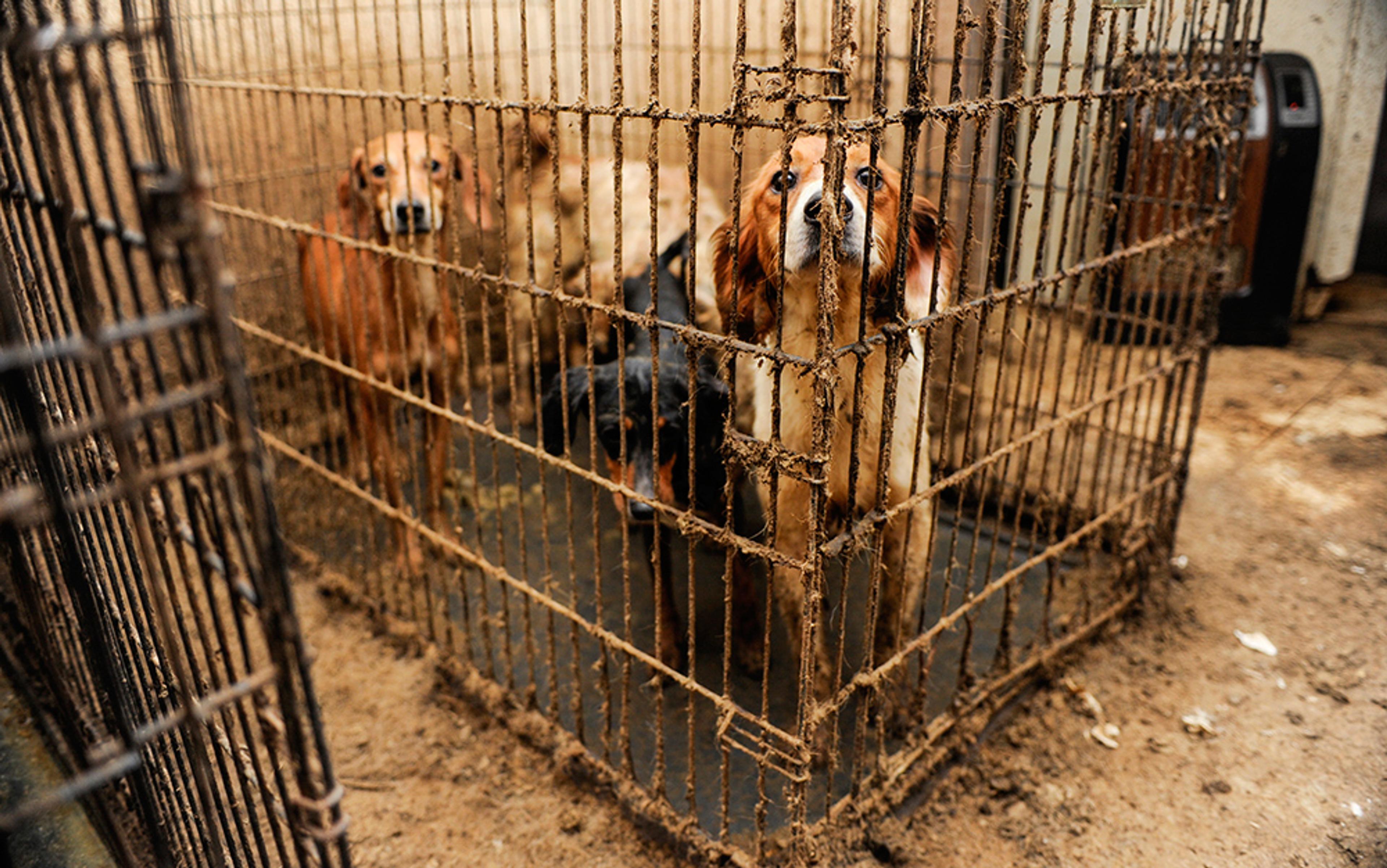Of the thousands of bodies in this room, only five of us reflect the fluorescent lights. A low ceiling fan blows germfree air down onto the stainless-steel countertop and over three mice in an open cage, and their sister wriggling between my thumb and index finger.
As I pinch back the loose skin over her shoulders, her forearms splay outward. She pumps her hind legs as if swimming. I hesitate. Then, with a hole punch that I could use for office paper, I divot the lower edge of her right ear. It’s a kind of branding, a way to identify her, mouse A, the first of four from cage 896. To collect her DNA, I use scissors to cut off a snippet of her tail. With forceps, I drop the snippet into a small plastic tube, a microcuvette marked with a Sharpie pen: 896A.
Beside us, her cage looks like a shoebox. Moulded from clear plastic, its floor is lined with a thin layer of paper bedding. Because her cage is difficult to cover while I’m holding a mouse, it lies open. In the dark behind us, shelves contain hundreds of shoeboxes just like it.
One of her sisters sits in the corner of the open cage. The other two scale its wall. One folds her belly over the rim, like a child pulling herself out of a pool. The other walks its rim, balancing as if on a high wire. I sense she’s working through options: ‘Leap from the cage I’ve spent my life trying to escape? Or retreat back inside?’ With freedom right there, they nearly always jump back to the familiar.

Image supplied by the author
I am also working through options. I keep mulling over a quote by the American writer and muckraker Upton Sinclair, whose book The Jungle (1906) exposed conditions in the meatpacking industry. ‘It is difficult to get a man to understand something,’ he used to say, ‘when his salary depends upon his not understanding it.’
I don’t cut flanks from sirloins. As a professor at a medical school, I’m paid to teach and run a research laboratory of mostly grad students and technicians. My job is, at least, to try to understand.
We conduct experiments on mice to help determine what makes a person susceptible to autism. To identify its genetic causes, my lab invented behaviour tests to determine whether certain strains of mice enjoy the company of their peers. Our experiments generally go well, so long as we imagine how we might feel if we were in a mouse’s situation. For instance, since the students in my laboratory noticed that feeling stressed left us less sociable, we decided to test mice under comfortable conditions. Since mice are nocturnal – active and sociable in the dark – we would study them under red lighting, a hue they can barely see, amid soft bedding. Bucking the convenient approach for scientists – studies under bright lights on steel flooring – we got good results.
Lately, though, I’ve been questioning my research, wondering whether our studies of mice could ever help people with autism. My thoughts keep circling, scouring through the same, seemingly barren plot of scientific questions. What am I missing?
I think back to a presentation I heard years earlier by Thomas Insel, then director of the US National Institute of Mental Health. The institute funds scientific research to discover new drugs for treating psychiatric illnesses. Most scientists finish presentations with some variation of ‘we are on the brink of discovery’ but Insel concluded with a different point. Animal research, he said, had failed to generate a single new category of psychiatric drugs in more than 50 years. New drugs on the market were mostly redesigned or repurposed versions of existing drugs. He’d funded brilliant experiments, yet scientists were coming up empty-handed. We needed to do something different. The candour of his words would stick with me. It sounded like a plea.
Glancing back down at the mouse wriggling between my fingertips, I feel her twists and kicks through my latex gloves. I return her to her cage, then snap shut the microcuvette. She scurries to one corner, turns, huddles, and faces centre. Her whiskers quiver. One sister quits bellying the cage rim and drops back inside. Her other sister still walks the rim. For a split second, I wonder if I would feel sociable living in a small cell with three other people in such a sparse landscape, only able to take a few steps forward in any direction.
Another day on campus. I’m a few minutes late to interview a candidate for our department chair. I’m the last of the five faculty to arrive. No way to sneak in.
The room is small, the lights are bright, and the white Formica-topped table is far too big for the space. I edge toward my seat. Somebody mentions how the weather is not always this nice in April. Another quips ‘or in June’. In the Pacific Northwest, it often rains in June. A few people chuckle.
I pull out a chair, trying not to draw more attention. A senior colleague sits across the table, her hands clasped, looking down at a sheet of paper. ID badges hang off lanyards on two faculty. Several have enamel pins on their lanyards that read ‘I care.’ At one corner of the table sits an unfamiliar woman. I nod and smile at her. She nods and smiles back, then looks down at her cellphone. I presume she’s the focus of our meeting. Our group shares with the candidate an interest in neurodevelopment: how the brain develops and matures. Some of us work with humans, others with rodents, a few with monkeys. My goal is two-fold: to get some inkling of whether she’d be a good department chair, and to curry favour with her on the off-chance she gets the job and remembers the interview.
The senior professor unclasps her hands, straightens her back, then picks up the candidate’s itinerary, a sheet of paper listing her many appointments for the day. The gesture stills everyone in the room, save the one beside me who continues typing into his laptop.
From a platform on a high metal barricade, they can watch the few monkeys who live outdoors
‘You visited the West Campus today?’ the senior professor asks.
My colleague stops typing and closes his laptop. The West Campus includes one of the few federally funded primate centres in the United States, housing more than 5,000 monkeys. We talk about the grounds. A privilege to visit, you need special clearance to get past the guardhouse. The grounds were clearly designed by landscape architects. Picture an enchanted forest of towering Douglas firs, sequoias and Japanese red maples, with garden lights and azaleas peppered beneath. Quiet, too – save the slow roll of an occasional passing car. You can hear birdsong.
For visitors, the campus offers ‘the tour’. From a platform on the rim of a high metal barricade, they can watch the few monkeys who live outdoors: sitting in the grass, grazing on biscuits. Red-tailed hawks also live nearby. When they fly above the campus, they can soar over the monkeys that live outdoors – strangely, the only place on campus with no trees to climb.
‘Yes,’ the candidate responds, ‘such a beautiful campus.’
Sitting in our sparse conference room, I now imagine a different bird’s eye view. I see several faculty members below, crammed shoulder-to-shoulder, sharing stale air.
How did I get here?
In the 1990s, I was working on my PhD dissertation in immunology. AIDS was raging and scientists were hard-pressed to find a vaccine, much less a cure. As a graduate student, I mostly worked in a laboratory and ran experiments. Three years in, about halfway toward my diploma, I met with our graduate programme director. He was classic, anachronistic even: goatee, ascot, cardigan, corduroys. After we talked about my mouse experiments, we turned to his concerns. The faculty members were debating whether to add the word ‘molecular’ to the title of our graduate programme. He wasn’t keen on the idea.
At the time, ‘molecular’ was the buzzword, shorthand for molecular biology, science’s newfound ability to manipulate DNA. For a mouse or a human, this code embodies around 20,000 genes written with four characters, near 2.5 billion of them – aeon’s worth of accumulated knowledge, longer than 3,000 Bibles or 7,500 Qurans.
Using molecular techniques, scientists could mix and match DNA, make a batch of mice, then watch them walk on their own. Literally rewriting the script of evolution, we could genetically engineer mouse models of disease featuring various aspects of human illnesses – depression, diabetes, schizophrenia, autism, cancer – then search for drugs to cure them. If scientists could find a drug that could render these mouse models of disease ‘healthy’, they might have discovered a drug for human use. Our work felt God-like in its mission: with molecular biology at our fingertips, we could bring to life creatures that natural selection would never permit, then conquer human suffering.
‘Technologies,’ he griped, ‘should never dictate our questions’
As you might expect, ‘molecular’ also came with a financial windfall. The US National Institutes of Health more than doubled its budget over the 1980s, investing heavily in animal experiments that capitalised on the new molecular techniques. You could see our newfound wealth in the sparkle of our remodelled laboratories. Even our equipment looked smart: cream-coloured countertop microcentrifuges and thermocyclers, clear plastic gel boxes, and electrophoresis tanks. A whole symphony of affluence. Centrifuges latched shut like the doors of luxury cars. Rotors whizzed like miniature jet engines.
Yet, that old advisor grumbled, if graduate students were learning how to manipulate DNA, then a doctorate in philosophy meant no longer learning about pathology, how organisms cope with the impositions of our environments: pathogens, wounds, malnourishment. Soon, he groused, scientists would ask only the profitable questions our molecular biology techniques could answer. ‘Technologies,’ he griped, ‘should never dictate our questions.’
I didn’t know what to make of it. Was this wisdom or sour grapes? Was he stuck in his old ways, resentful because his mind was no longer nimble enough to learn the new techniques? After I finished my dissertation, I headed straight to a molecular lab where I would create new kinds of mice and study them. The years that followed were pure adrenalin.
Thirty years later, our molecular revolution firmly established, we should have plenty to boast about. But do we? Not exactly. When present-day scientists defend animal research, we often tout discoveries made more than a century ago: a treatment for diabetes from studies of pigs and dogs, a polio vaccine from experiments on monkeys. Pointing to that distant past, I suspect we betray our failures.
While universities invested their windfalls to erect radiant laboratory buildings with gleaming hallways, glass atriums and cathedral ceilings, they allocated nothing to the complexity of the animal cages. To keep housing costs down, cages remained cramped and impoverished, with only enough space to eat and breed. Even today, the standard cages used to house laboratory rats are not high enough for them to stand up straight. Flat out, a laboratory mouse can run six cage lengths in under a second. Rhesus macaques, primates used because they resemble humans, get living spaces inside steel cubes that are barely twice their height.
Still, not a single scientist I knew was asking whether such impoverished confinement might render our ‘animal models’ irrelevant to questions of human health.
For decades, neither did I.
The first clue that something was awry came from a failed experiment, around 2007. To identify mice with autistic-like traits, my laboratory devised an experiment to ask whether certain mouse strains, given a choice, would favour a food reward over a social encounter. Since autistic children often play alone, we reasoned that young autistic-like mice would head straight for a food reward, not stopping along the way to socialise.
To test our hypothesis, we designed the ‘Social Gauntlet Test’, a reference to a movie I saw as a teenager, where the hero brings a witness to testify against a police commissioner. By the end of the movie, he drives an armoured school bus right up the courthouse steps through a gauntlet of police officers and gunfire.
They were fixated on something – a smell, a breeze, a sound – that we couldn’t detect
For our Social Gauntlet experiment, we built a test structure out of black sheet plastic. It had multiple walls but no ceiling, so we could observe the test mice and record their movements with overhead video recorders. From above, the structure looked like an arrow, a triangle-shaped entrance foyer followed by a shaft of thin runway lined on either side with narrow cages. A mouse would be placed in the foyer, find the runway, then walk past the gauntlet of caged mice to get to the chocolate flake, a treat we learned from previous tests that they liked most.
When we initially trained the mice, the cages on either side of the runway were empty. On the afternoon before test day, we isolated our test mice – one mouse per cage – and took away their food. Hungry, we reasoned, they would ‘run for chocolate’. Isolated for a day from their peers, they would also be craving a social encounter.
The next afternoon, we added mice to the cages lining the runway, then ran our tests. Overall, our mice behaved as predicted. Our control mice generally slowed down to sniff their jailed peers before travelling to the chocolate flake. Some nuzzled every peer. Others stalled to rub noses with one individual. A few walked directly to the chocolate, then turned around, kicking the flake to the side to greet their jailed peers before returning to look for their food reward. Mice from the autistic-like strain, on the other hand, mostly walked straight to the chocolate flake.
But, analysing the data, we discovered a design flaw in our test structure. We had built it to be adjustable because we didn’t know in advance how wide to make the runway: too wide and the test mice might ignore their jailed peers, but too narrow and they might feel overwhelmed by the social situation, staying put in the foyer instead. To make the structure adjustable, we built the corners out of hinges.
During testing, some of the mice would notice the hinges, then become preoccupied with them. Despite being hungry for food and starved of social interaction, they snubbed the chocolate and dismissed their peers. We couldn’t get statistically significant results because many of them were captivated by the hinges. They pressed their snouts and paws into the hinges’ narrow vertical slits, sometimes for the duration of the five-minute test. They were fixated on something – a smell, a breeze, a sound – that we couldn’t detect and evidently with a drive far more compelling than eating or socialising. Was it curiosity? Or were they trying to escape?
Searching for an explanation, I learned about the novel object recognition test, a widely used and highly cherished measure of rodent learning and memory that relies entirely upon the rodent’s curiosity. In this test, the experimenter places the rat or mouse inside a small arena with two objects. After the rodent becomes familiar with the two objects, the experimenter removes him from the arena, replaces one of the objects with a novel one, then brings him back. If he remembers the familiar object, he spends more time sniffing the novel one. This test measures a rodent’s cognitive abilities – learning and memory – but the behaviour is motivated by an underlying drive to investigate. Some scientists call this motivation ‘exploratory drive’, others call it ‘sensation seeking’.
For a wild animal, curiosity can be essential for survival. For instance, wild animals don’t always consume as much high-energy food as their bellies can hold. Nor do they dependably forage at the best feeding spots. Sometimes, they nibble on unknown foods of questionable caloric value, as if to check them out. Sometimes, they forage in less well-travelled areas, despite the dangers. If they don’t get sick, they might try it again. Curiosity buys a creature an insurance policy for when traditional approaches no longer apply. If the apples disappear, maybe the persimmons will work.
Not all behaviours are learned. Some are hardwired, like the blinking of an eyelid. If they’re always essential, we might inherit them from our ancestors, without having to learn them. Some people call these hardwired behaviours ‘innate’. But such genetically inherited pre-programmed behaviours can’t accommodate the multitude of unpredictable challenges we typically encounter. For those unexpected situations, we need to adopt a flexible behavioural repertoire. That flexibility requires both a cognitive ability to learn – and the motivation to do so.
For a brain to fully develop, it needs places to go, novel sensations to experience and problems to solve
To adapt to an environment, animals benefit from three motivations: seek pleasure, avoid pain and learn what aspects of the environment predict the difference. You might consider motivations for animals as akin to gravity for objects. Both are invisible. We infer them from physical actions. They can get us moving. They can hold us in place.
By seeking pleasure, avoiding pain and learning what predicts the difference, a newborn mouse can adapt to the various temporal and physical conditions of her birth, whether nested beneath a floorboard, burrowed under a wheat field, swaddled inside an old car engine, or tucked in the rafters of a barn. A mouse can take advantage of what she might stumble upon: seeds, tubers, crackers, oats, worms, crickets, junk food. She can learn what to avoid: road traffic, cat dander, glue traps, hawks.
What’s more, 70 years of animal experiments tell us that a brain doesn’t just crave novel experiences, it feeds upon them. For a brain to fully develop, it needs places to go, novel sensations to experience and problems to solve. Scientists have had inklings of this phenomenon since at least the late 1940s, when Donald Hebb, an early pioneer in neuroscience, asked whether lab rats would be any smarter after living as pets. He brought rats home to live with his daughters. He wrote that the rats were ‘out of their cages a good deal of the time and running about the house.’ Then, when he ran them through mazes, he discovered that the pet rats were smarter than his lab rats. They could learn from new experiences, ‘one of the characteristics of the “intelligent” human being.’
Decades later, William Greenough, another icon in neuroscience history, asked what slight improvements to the harsh impoverishment inside a standard cage could do to a rat’s physical brain. He afforded them slightly bigger cages with added blocks and tunnels. Looking through the lens of his microscope, he saw that their brains were more densely packed with neurons than those of the rats from standard cages. And their neurons appeared more differentiated, elaborating with more abundant branching. While the capillaries, the smallest blood vessels that nourish these neurons, bourgeoned under the ‘enriched’ conditions, they looked anaemic in rats housed in standard cages.
By the year 2010, scientists had discovered how environmental complexity reshapes a rodent’s brain and enhances its function: a molecular process called epigenetics that turns some genes on and others off. Reflecting on more than 70 years of neuroscience experiments, we can see one undeniable reality: for an integrated biological system – a living being – environmental complexity matters. A brain flourishes with challenges to overcome, opportunities to explore and novel experiences.
Back at the stainless-steel countertop, a world of difference exists between the two of us. Her whiskers quiver as if tapping invisible air-borne particles. She hears sounds octaves beyond my auditory range, perhaps the ballasts of the fluorescent lights. She might smell the blood on my latex gloves. Her eyes have no whites. I don’t know if she looks at me. Perhaps, she feels my pulse.
What keeps us from understanding that their cages jeopardise the relevance of our science?
One Christmas morning, my students gone for the holidays, I’d toured our mouse colony to do the health check, which amounted to surveying every cage for empty water bottles, mice with hunched backs or scruffy fur, blood smears on the cage walls, and dead animals in the bedding.
Not yet fully awake, I forgot to flip on the light switch before entering the colony room. I walked into darkness and what sounded like dozens of people lightly sanding away at the walls. The door let in some light, so I peered inside a cage. Two mice were reaching for bedding ahead of them, pushing it through their hind legs, piling it behind them, moving forward, turning near the walls, shovelling again, methodically digging back and forth across the cage like miniature tractors harvesting wheat. I glimpsed into other cages and saw more of this same, seemingly frantic behaviour. When I flipped on the light switch, nearly 140 cages of activity went silent.
I learned later that, in the wild, mice excavate underground burrows: subterranean mazes of tunnels, intersections, chambers and cul-de-sacs. As a surface-dwelling creature, it wouldn’t occur to me that a mouse might feel compelled to quarry, to find some edge to pull on, some soft spot beneath the bedding that might give way.
I would often think about this moment. What if caged mice felt frustrated because they couldn’t dig through the plastic flooring beneath the bedding? And, if so, without a doubt some mouse strains would feel more frustrated than others. If those differences in their frustration levels influenced their interests in social interactions, then my lab would not be studying the biology of sociability. We would be studying the biology of frustration. My research, with all the millions in federal dollars used to fund it, would be useless for understanding autism. We would be studying the artefacts of living inside a shoebox cage.
Scientists often defend our need for cages ‘to control the variables’. In practice, cages do not control the variables
And what if the mouse models of other diseases – depression, anxiety, addiction, attention deficit (ADHD) – were also affected by the artificiality of their cages? In the wild, mice roam territories hundreds of thousands of times more expansive than the footprint of a standard cage. They get full use of their bodies, new challenges, and authorship of their experiences – for instance, whether to socialise or be alone. They take risks and learn from them. With all of this denied them, how much of our biomedical research enterprise was focused on artefacts of impoverished captivity?
For a while, I took solace in thinking that caged monkeys have it far worse than my mice. Still, for decades I couldn’t grasp that the perspectives of my mice also mattered. What blinds us from seeing that caged animals – staring for life at walls – might have warped psychological experiences and aberrant brain development? What keeps us from understanding that their cages jeopardise the relevance of our science?
We depend on small cages to produce scientific papers – our bread and butter – and not just because I can pull 896A off the shelf when the time is right. Cages sensitise our animals so they readily succumb to whatever we do to them. For instance, in small cages, rodents become more readily addicted to drugs: heroin, amphetamines, alcohol. Put a few objects in their cages, and they’re generally not that interested in the drugs. The same pattern goes with other developmental challenges and mental illnesses – dementia, autism, stroke, anxiety, depression, schizophrenia, ADHD – which become significantly exacerbated when rodents are housed in standard cages.
Nor is this pattern restricted to mental illness. Animals in standard cages are also hypersensitive to wounds, infections, cardiovascular diseases, and cancers. Their susceptibility helps us publish papers. And this makes me wonder about the costs to human health. How many potentially useful drugs might have been shelved, never making it to human trials, because pre-clinical trials showed they were toxic to these hypersensitive animals?
Scientists often defend our need for cages ‘to control the variables’. Conceptually, this argument makes sense. Because caged animals get exposed to fewer random variables than freer animals, we can more readily discern how our chosen experimental variable, the stimulus, influences the biological outcome of interest, the response. But in practice, cages do not control the variables. Often incapable of replicating experimental results, laboratories have faced a reproducibility crisis because cages do not control the variables: not the ultrasonic noises in the rodent’s colony rooms, nor the phytoestrogens in the chow, nor the light levels inside the cages. And laboratories do not use standardised beddings. We can choose from corncob pellets; aspen, pine or hardwoods rendered into chips, pellets or shavings; paper products laundered into shreds, pellets, twists or fibres; even cellulose. For scientists, these variables are an administrative nuance. For laboratory animals, they are a life sentence.
With our candidate for the department chair, amid our chatter in that small room about the beautiful landscaping, I feel like I’m the obvious outlier, not just for being late, but also for being quiet. I feel at moments as though my colleagues can read my mind, as if they know I’m no longer a confederate. I can’t shake my memories of the monkeys. Were they angry? When I visited their colony rooms, I was instructed not to get too close to a cage, lest one grab a finger and bite it off. I had to wear a face shield and a disposable bodysuit to protect me from their spit. Whatever they could see of me was gowned up. Some monkeys could see others circling, somersaulting or rattling the doors of their cages. They could also hear latches bolt, metal doors slam shut, banging against walls, shrieks echoing against cinderblock.
So, why don’t I ever speak up? Why can’t I question aloud whether those monkeys might be so mentally crippled by living inside refrigerator-sized cages that they couldn’t possibly give us any meaningful data about autism or ADHD? And why can’t I speak to a possible solution? We could build indoor/outdoor enclosures where lab animals could author their experiences, face the consequences, and experience unpredictable challenges, like what might come naturally with the weather. What holds me back? Why can’t I mention that our rats and mice could live in mass-produced enclosures with outdoor access, like small research barns, where they would be allowed to burrow, run and form social alliances? Or that monkeys could get what we now call ‘sanctuaries’, vast fenced-in areas akin to what they might have in a forest? We have the remote technologies to study their biology from a distance! We have them in the phones we carry.
I could mention that, so long as we see laboratory animals only as mechanisms and neurocircuits, we will continue to miss the mark, not just in our understanding of mental illness but of other maladies – cancer, wound recovery, infectious disease, cardiovascular disease. These illnesses might flourish in animals only under the unnatural caged conditions that make life not worth living.
It wasn’t just that the animals suffered, but that their suffering didn’t matter
Yet at this meeting, like at every other previous meeting, I say nothing. Do I lack the courage to speak out? Do I fear being ostracised by the only membership that would have me? It is as if I were a member of a gentlemen’s club, in tacit understanding of unacceptable topics. Any mention of the internal experiences of our lab animals seems out of bounds among scientists. Perhaps, we fear that such talk, even in private, might bolster arguments by animal advocates to shut us down. Still, don’t we have a professional obligation to question our research? What if our antiquated cage technologies are dictating our questions? Shouldn’t we at least ask whether the perspectives of our laboratory animals affect the relevance of our experiments?
For me, it wasn’t just that the animals suffered, but that their suffering didn’t matter. Likewise, I saw researchers becoming trapped in careers without meaning, captive like the animals we cage: a different kind of learned helplessness. Perhaps, we project on ourselves what we see in other animals. Until we acknowledge that laboratory animals might have qualms with their captivity – and that their perspectives might taint our experiments – I suspect we will continue to paw at invisible surfaces, tap at our reflections, follow ourselves.
The conversation moves on, congenial in intonations, peppered with details, systematically ignoring the implications of our research. Struggling to find something to contribute, I remain silent. I begin to fear that my silence speaks of my growing doubts, more disruptive to the group than my bumbling late arrival. I have to say something.
‘Yes,’ I say, ‘the landscaping is gorgeous.’
Back at the stainless-steel countertop, I work on the mouse in hand. Meanwhile, the mouse on the cage rim takes the half-foot drop to the countertop. She’s that outlier, a true rarity, two standard deviations from the mean. She lands on the steel surface, limbs splayed, head still, whiskers quivering. With seconds to catch her, I lower the ear punch. She extends her head, lengthening her neck. I return her sister to their cage. She advances a front paw, the first time she’s ever stepped on steel. My palm sweeps across its surface. She darts, first behind the water bottle, then another cage.
The animal transfer station is cluttered: paper towels, the steriliser, forceps in a chlorine bath, other cages. I pull them away as if hunting through cracker boxes in a pantry. She crouches behind the steriliser, turns, then advances to the edge of the countertop. The next drop is almost a metre, a freefall into darkness. I open my hand to make a second attempt. She leaps from the countertop, 15 body lengths to the floor. I switch on the room lights. I look beneath the countertop, then peer around it. She’s gone.
If she avoids the glue traps, she might live off the stray chow beneath the racks and testing equipment. She might slip out the door when a caretaker rolls out the animal transfer station. She might get to the cafeteria, maybe the campus grounds. And for those few minutes, hours or perhaps days, she would be making decisions. She would be dealing with their consequences. She would be relevant.
